ISSN ONLINE(2319-8753)PRINT(2347-6710)
ISSN ONLINE(2319-8753)PRINT(2347-6710)
S.Jagatheesh Kumar1, G.Santhosh1, D.Nirmalkumar1, A.Saravanakumar2, Dr.P.Sasikumar2 and Dr.S.Sivasankaran2
|
| Related article at Pubmed, Scholar Google |
Visit for more related articles at International Journal of Innovative Research in Science, Engineering and Technology
This paper presents the wear behavior of Al6063 discontinuously reinforced with graphite and Aluminium oxide composite. Graphite is chosen because it has self-lubricating property which can reduce friction and also reduce wear. Al 6063-6% Al2O3, Al 6063-6% Al2O3-1% Gr composites were produced by stir casting method and then the samples strength and wear behavior were carried out by hardness test and pin-on-disc wear test apparatus. The obtained result showed that Al 6063- 6%Al2O3-1%Gr hybrid composite exhibited more wear resistance when compared to Al 6063-6% Al2O3 monoreinforced composite. It was expected that the addition of 1 wt.% Gr particulates might pin downed the wear. In order to judge the densification behavior, the samples were multi-axially forged and the strength of the samples was compared. The results showed that the multi-axially forged samples exhibited more strength than as-casted samples due to presence of pores in as-casted condition.
Keywords |
| AA 6063 Al alloy; Al2O3-Gr; metal matrix hybrid composite; pin- on- disc wear test. |
INTRODUCTION |
| In recent times, there has been a great upsurge in using aluminium based materials for various applications, especially in automotive industry, due to their enhanced properties such as elastic modulus, hardness, flexural strength combined with significant weight savings [1]. However, their applications are restricted because of their poor wear resistance under dry lubricating conditions [2]. To improve the wear resistance of aluminium alloy, reinforced with ceramic particles have been received extensive attentions due to their superior mechanical properties [3]. There are many investigations were interested in the tribological properties of the MMCs among the researches. The tribological parameters that control friction and wear properties can be classified into two types, namely extrinsic factors and intrinsic factors [4]. Among all these factors effect on applied load, volume fraction of reinforcement on friction and wear properties have been investigated by many researchers. In most cases, hard ceramic particulates such as Zirconia, alumina (Al2O3) and silicon carbide (SiC) have been introduced into aluminium-based matrix in order to increase the strength, stiffness, wear resistance, corrosion resistance, and elevated temperature resistance. Among these reinforcements, Al2O3is chemically compatible with aluminium (Al) and forms an adequate bond with the matrix without developing inter-metallic phase [5]. |
| However the additions of brittle reinforcement are sensitive to cracking during severe wear conditions. Other problem associated with ceramic reinforcements is their tendency to remove from the matrix. Under these conditions, fragment of reinforcement can act as a third body that increases the aggressiveness [6]. |
| Traditionally, the self-lubricating materials are more desired because they avoid the periodic application of external lubrication. And also it helps to allow the element work at a higher temperature. Graphite is one of the most frequently used solid lubricants and its application as reinforcement in aluminium matrix composites [7]. The combination of hard ceramic particles, such as Al2O3 ones, with self-lubricating reinforcements, such as graphite particle, to produce a hybrid reinforcement system combines to improve the wear resistance of aluminum alloy [8]. Akhlaghi [9] reported that during dry sliding, the metal/Gr composites, a continuous layer of solid lubricant forms on the tribo surface [9]. This lubricating film is formed as a result of shearing Gr particles located immediately below the sliding surface of the composite. This Gr rich lubricant film helps to reduce the magnitude of shear stress transferred to the material underneath the contact area, alleviates the plastic deformation in the subsurface region, prevents a metal-to-metal contact.The limitation with the aluminium graphite composite is in using graphite as a solid lubricant whose introduction results inthe loss of strength of the composite. |
| Kok and Ozdin [10] investigated the effect of Al2O3 particle content and size on the wear behavior of Al2O3 particle reinforced 2024 aluminium alloy composites fabricated by vortex method. Surappa et al. [11] have studied the influence of 5 vol.%Al2O3 particles addition on the wear resistance of hyper eutectic Al–Si alloys.]. In the liquid casting technique, the particulates are mechanically welldistributed over the liquid metal before casting and solidification . These methods are typically cost effective. |
| The main objective of the present work is to study the dry sliding wear behavior of Al 6063-6% Al2O3-1% Gr hybrid composite using Pin-on-disc apparatus. |
EXPERIMENTAL PROCEDURE |
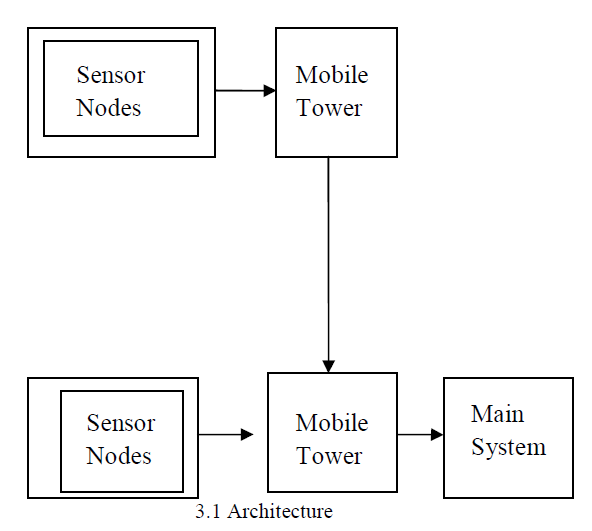 |
Manufacturing of composites |
| The Al 6063-6% Al2O3hybrid composite and Al 6063-6% Al2O3–1% Gr mono reinforced composite were fabricated by stir casting. The chemical composition of Al 6063 is given in Table 1. The reinforcing material selected was Al2O3 of particle size of 20 μm and Graphite used as second phase reinforcement with its fixed weightof 1%. |
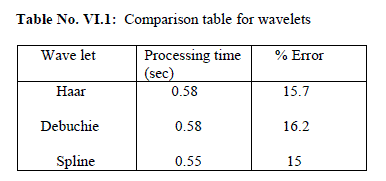 |
| Stir casting of MMCs involves producing a melt of the selected matrix material, followed by introducing reinforcement material into the melt, obtaining a suitable dispersion through stirring. Al alloy was melted at 800ºC in a Graphite crucible in an induction type electric resistance furnace. Before that preheating of the reinforcements were carried out because if any moisture content is present in reinforcements may cause adverse effects in process. Both Gr and Al2O3 are kept in smaller crucible and heated by pre-heating furnace for 25-30 minutes at 400-4500C. The Stir casting setup used is shown in Fig 1. |
| After completion of melting and degassing of the alloy by Hexa-Chloroethane (CCl6),stirrer was introduced into the molten Al alloy and stirring was started.The stirrer was rotated at 465 rpm for 20min. The depth of immersion of the stirrer was maintained at about two thirds the depth of the molten metal. During stirring, the mixture of preheated reinforcement particles Gr and Al2O3 was added inside the molten metal and then the vortex was formed due to stirring. After stirring, the crucible with the composite alloy was taken out from the furnace and tilted to pour it into the preheated permanent steel mould and allowed to cool in atmospheric air. After cooling, the solidified composite material is taken out from the mould. By this method various composition of samples were manufactured. |
Hardness test |
| In order to test the mechanical properties of various compositions of hybrid MMCs it should be machined according to the ASTM standards. The samples for hardness test were machined as per ASTM E18-12 standard of 10*10*10 mm cube. The hardness test was conducted using Rockwell superficial hardness tester HR(15T). |
Wear test |
| The samples for dry sliding wear behavior were prepared as per ASTM G99-G59 standard using electric discharge machining.Dry sliding wear experiments were conducted using a computer aided pin-on-disc wear testing machine at constant sliding velocity (V = 2.932 ms-1) and constant load on the pin was 20 N while the sliding distance of 1172 m was maintained. Thewear tests were conducted at room temperature in accordance with ASTM G99-G59 standard (diameter of the pin was 12 mm and 20 mm in length). During wear testing, height loss experiencedby the pin specimen was measured in microns. Wear loss (mm3/m)was calculated using the formula. |
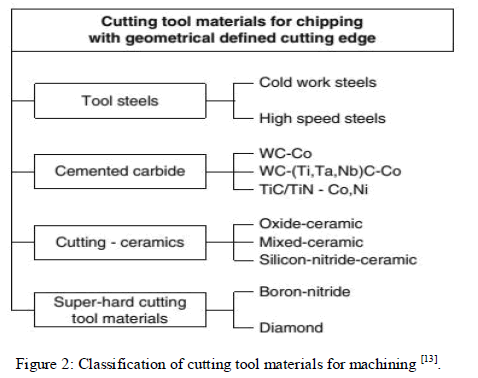 |
Multi Axial Forging |
| Multiaxial forging is a forging process in which the specimen is rotated by 90 degrees after each forging pass. Fig.5 shows the arrangement before and after the first pass, and before the second pass. It can be clearly seen that the shape of the specimen changes as a barrel. The rate of plastic deformation is very high, so it is a dynamic deformation process. Here the samples were subjected to three cycles of forging. The Fig.6 shows the multi axial forging process using the D3 steel die in universal testing machine (UTM). |
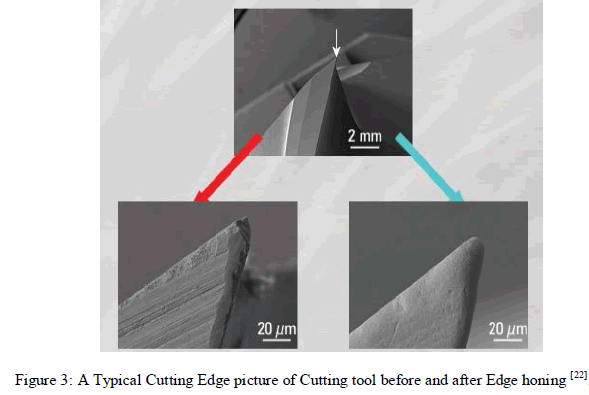 |
RESULTS AND DISCUSSION |
| To investigate the mechanical and tribological behavior of fabricated composites of Al 6063, Al 6063 – 6% Al2O3 and Al 6063 – 6% Al2O3 – 1% Gr, hardness test and wear teat was carried out. |
Micro structure |
| Fig.7and 8 are the opticalmicrographs of the polished surfaces Al 6063-6 % Al2O3-1 % Gr hybrid composite in as cast and multi axially forged condition respectively. From the Fig. 7, it was observed that uniform distribution of reinforcement of Al2O3 particles were observed throughout the matrix. Further, it contains coarse grain matrix with an average matrix grain size of 70 m. The Fig. 8 clearly shows the ultrafine grain matrix with average matrix grain size of 0.75 mwere formed due to the multi axial forging. Due to the grain refinement the properties of the material increased because of absence of porosity. |
 |
SEM analysis |
| Since the addition of reinforcements was done at the higher temperature, there is chance for disintegration of reinforcement particles. During the casting process the graphite and alumina particles may be removed as slag during the pouring of molten material in to the die. So it is necessary to show the presence of reinforcements in the matrix material. And also in order to find the distribution of reinforcement materials in the matrix SEM analysis was carried out. The Fig.9 clearly shows the uniform distribution of Al2O3and Gr throughout the matrix. It is expected to possess better mechanical properties due to uniform distribution of reinforcement. |
 |
| Fig.9 SEM Photograph for 6% of Al2O3 and 1 % of Gr (As cast condition) |
Hardness studies |
 |
| Hardness of different samples was carried out and results are shown in Fig.8. It is observed that the Al 6063-6% of Al2O3 having higher hardness than other two samples due to addition of hard reinforcement. The decrease hardness with addition of 1% of Gr in the composite is also shown in Fig.10.Compared to cast condition the multi axially forged samples possess higher hardness. This is due to grain refinement engendered during multi-axial forging and hence the mechanical properties was increased. |
| The SEM photograph (Fig.9) reveals the reason for improved strength of 6% composite i.e. uniform distribution of reinforcement. In order to further removal of porosities and improvisation of strength, multi axial forging was done on the optimal composition alone in order to study the effects of the forging. |
Tribological studies |
| The variation in the measured wear rate and coefficient of friction with addition of Al2O3 and Gr in the composites under dry sliding condition is shown Fig 9 and 10 respectively. The tribological property for the present investigation is shown in Table 3. |
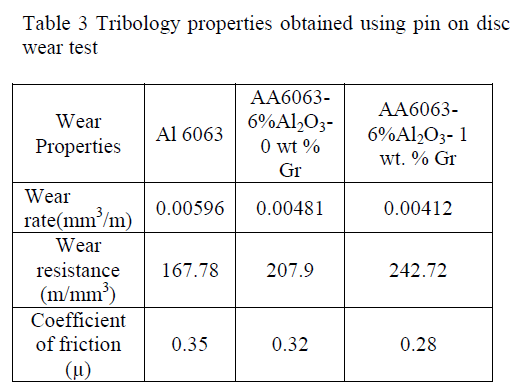 |
| From the Fig.11 it can be seen that Al 6063 having higher wear rate than other samples due to soft ductile phase. It was clear if adding reinforcement means the wear rate of composites decreases as the reinforcement acting load bearing element. The dry sliding wear of composite decreased when addition graphite content in Al 6063 with 6% wt. of Al2O3.From the SEM analysis Fig.9it can be seen that the graphite particles are well distributed within the Al 6063 with 6% of Al2O3 and noagglomeration of the graphite & reinforcement particles could be seen in the matrix. |
 |
| It could be seen that the graphite particles were distributed within the base alloy. These results are consistent with the trends reported by some investigators (Mustafa, 1994)who found that Al/Gr composites containing small amounts of graphite (2–5 wt. %) posses superior wear properties over the base alloy, whereas at higher graphite addition levels a complete reversal in the wear behavior was observed. |
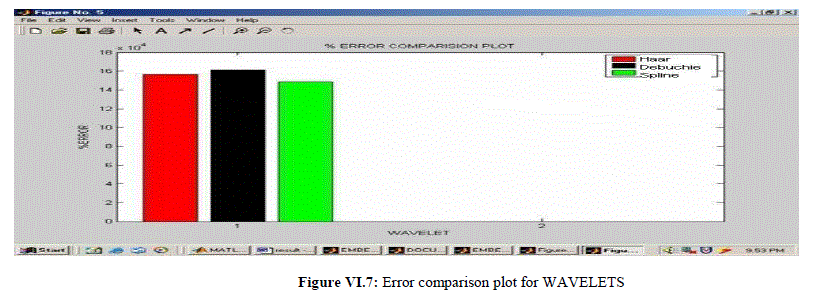 |
| From the Fig.13, the friction coefficients starts at 0.35 for the base alloy and decreases with the value of about 0.28 for composites containing 1wt. % graphite.The reason for this reduction in coefficient of friction could also be attributed to the presence of the smeared graphite layer at the sliding surface of the wear sample which acted as a solid lubricant. |
 |
| The micrographsshows the numerous long grooves and craters on worn surfaces. From the Fig.15 it is clear that, the of Gr particle helps to form a tribo layer on the contact surface. Due to the formation of tribosurface it will reduce the abrasive grooves. Also the frictional heating during the wear contributed to the oxidation of the finer debris more easily than the coarser ones. The oxide layer prevented metal to metal contact. This might be the reason why the alloy as well as the composite showed a different wear rate depending upon the level of oxide layer formation during the test. The micro grooves of the material were one of the interesting scenarios observed at room temperature.This lubricant film prevents direct contact of the two surfaces. During wear, the base alloy surface was subjected to severe plastic deformation and abrasive the amount of graphite addition increases, more graphite is released to the wear surface |
 |
| during the wear process. This film was expected to form as a result of shearing of graphite particles located immediately below the contact surface. This may be attributed to variations in the area covered by smeared graphite during sliding. The decreased coefficient of friction in Al/Gr composites was occurred due to addition of graphite particles. |
CONCLUSION |
| Based on the hardness and wear tests conducted on the Al 6063 alloy by addition of Al2O3and Graphite the following conclusions were made: |
| • There was a steady increase in hardness of Al 6063 alloy with increase in the percentage of Al2O3 in the mixtureup to 6% due to dispersion strengthening of Al2O3 |
| • The SEM analysis for Al 6063-6% of Al2O3-1% of Gr composite clearly shows the uniform distribution of reinforcement throughout the matrix. |
| • The hardness values of Al 6063 alloy increases when the alloy was multi axially forged due to grain refinement |
| • The addition of Graphite to the Al 6063 alloy with Al2O3 reduces the wear rate of the alloy there by increasing the wear resistance due to the self lubricating properties of Graphite |
| • The reason for this reduction in coefficient of friction due to the addition of graphite to the Al 6063 alloys could also be attributed to the presence of the smeared graphite layer at the sliding surface of the wear sample which acts as a solid lubricant. This lubricant film prevents direct contact of the two surfaces. |
ACKNOWLEDGMENTS |
| The authors express their gratitude towards the management of K P R Institute of Engineering, Coimbatore, for their support and encouragement duringthe research studies. |
References |
|